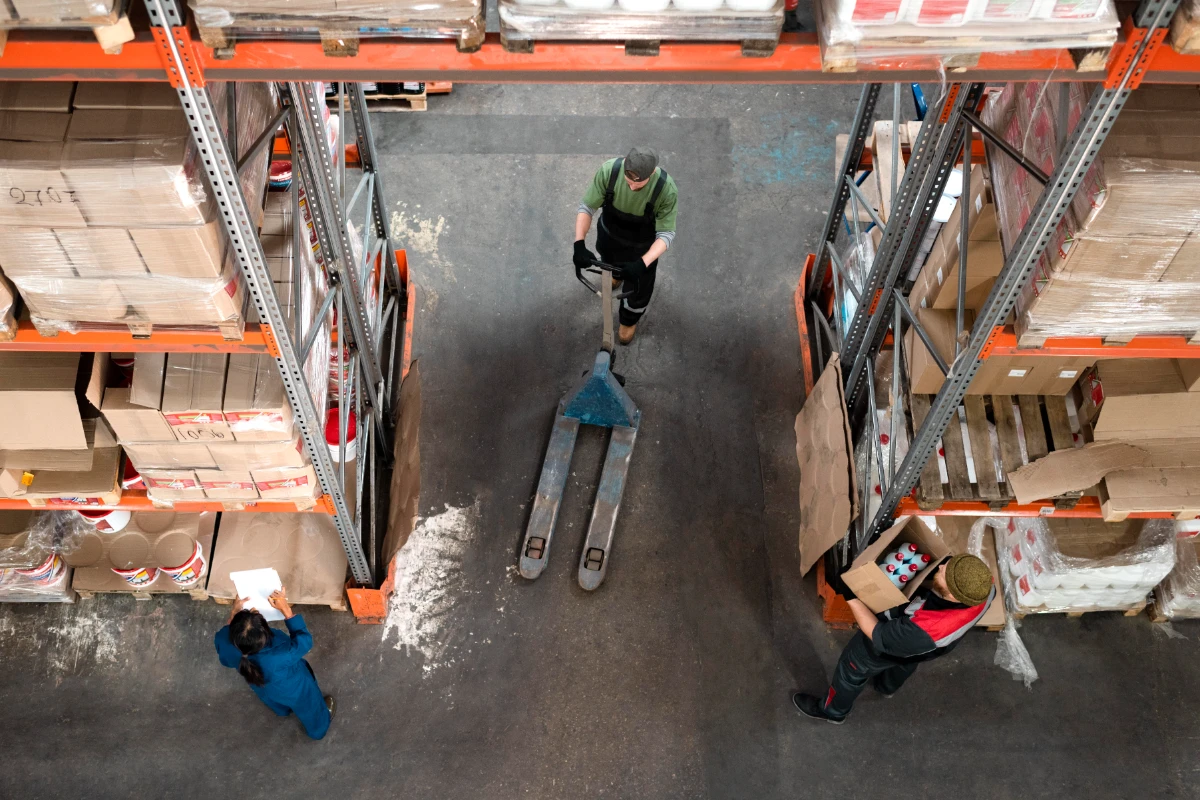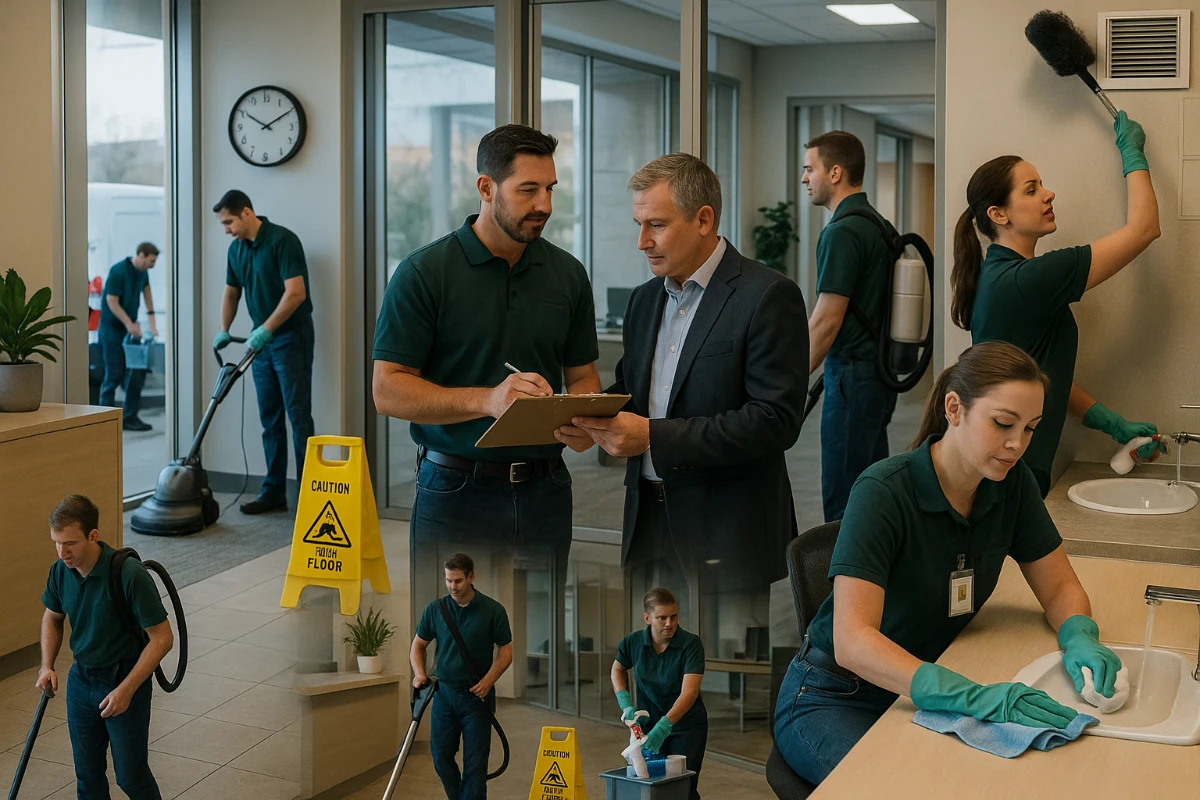Keeping floors and aisles dry and clear, cleaning up spills immediately, removing broken pallets and loose packaging, controlling dust on racks and beams, preventing docks from becoming slip zones, and using the proper equipment to clean chemical and battery areas are some cleaning tasks that you simply cannot ignore if you care about OSHA warehouse safety. These are not “nice extras.” These are fundamental safety measures that aid in preventing slips, trips, falls, falling goods, chemical exposure, and fire hazards—all of which OSHA expressly identifies as frequent issues in warehousing.
If you run or manage a warehouse in Baltimore, MD, getting these cleaning tasks right is one of the easiest ways to protect your people and sleep a little better before that next OSHA visit.
Why Cleaning Is Wrapped Into OSHA Warehouse Safety (Whether You Like It or Not)

According to OSHA’s warehouse safety pocket guide, forklifts, inadequate hazard communication, poor stacking, blocked exits, and hazardous walking surfaces are among the most common causes of fatal injuries in warehouses, which have a higher rate than the national average.
Look at that list and you realize:
If the floor is slick, cluttered, or dusty, forklift accidents get more likely.
If aisles and exits are blocked with trash or product, you’ve got a problem the moment there’s an emergency.
If chemicals spill and nobody knows how to clean them up safely, you’ve got health and fire risks.
So when we talk about OSHA Warehouse Safety, we’re not just talking about training forklift drivers and hanging safety posters. A lot of it comes down to very unglamorous, very routine warehouse cleaning.
Task #1: Keep Floors and Aisles Clear, Dry, and Boring
“Boring” is exactly what you want your walking and driving surfaces to be.
OSHA expects floors and aisles to be clear of slip and trip hazards. That means:
- No plastic wrap “snakes” on the ground
- No loose banding or broken pallet chunks where people walk
- No mystery puddles from leaks, rain, or product
- No stacked product spilling into the travel path
In real life, this looks like:
- Training everyone to stop and clean a spill instead of stepping over it
- Giving workers enough bins and Gaylords so trash doesn’t pile up “just for now”
- Building quick floor checks into shift change or lunch breaks
If people in your building regularly walk around the same wet or cluttered spots, OSHA won’t see that as a housekeeping slip – they’ll see it as a safety culture issue.
Task #2: Treat the Dock Like a High-Risk Zone (Because It Is)
OSHA calls out docks as a major danger area: forklifts running off the edge, products falling, and people getting hit.
Cleaning and safety go hand in hand here:
- Sweep dock plates, ramps, and thresholds throughout the day
- Get rid of loose boards, busted pallets, blown-in trash, and wrap
- Mop or scrub oil and grease from where trucks back in
- Make sure nothing blocks visual warnings near dock edges
If your docks in Baltimore get slick in winter thanks to melted snow and salt, that’s even more reason to tighten up cleaning around entrances and dock doors.
Task #3: Dust, Racks, and All the High Stuff Nobody Wants to Deal With
Dust feels harmless until it isn’t. OSHA and related safety guides flag general housekeeping and air quality as key pieces of warehouse safety. Excess dust can:
- Bother people’s lungs
- Build up on lights, wiring, and equipment
- Add fuel in a fire
The trouble spots are usually:
- Top levels of pallet racking
- Beams and structural steel
- Light fixtures and fans
- Conveyor supports and catwalks
This is where professional commercial cleaners earn their keep. They bring lifts, high-reach vacuums, and training to work at height without turning the job into its own safety risk.

Task #4: Packaging Waste and Broken Pallets – Small Stuff, Big Problems
Look around most warehouses and the “housekeeping” issue is obvious:
- Plastic wrap tails
- Strapping clips
- Cardboard scraps
- Broken wood from pallets
OSHA’s material handling guidance stresses secure, stable stacks and clear walking and driving areas.
A simple, human-friendly system helps a lot:
- Put waste containers where people actually work, not 50 yards away
- Have a clear home for broken pallets (and a schedule to remove them)
- Make someone responsible each shift for doing a quick “trash walk” in problem areas
You don’t need a big program to fix this – just clear rules and the expectation that nobody steps over trash “just this once.”
Task #5: Chemical Storage and Spill Cleanup Done the Right Way
OSHA is very clear on this: if you have chemicals, you need hazard communication, safety data sheets (SDS), training, and a written spill control plan.
From a cleaning point of view, this means:
- Everything should be labeled — no mystery spray bottles.
- Spill kits stocked, visible, and close to where chemicals are stored
- Staff trained on when not to clean something themselves
- Clear instructions on how to bag, tag, and dispose of used absorbents
This is not “mop and bucket” work. If your team in Baltimore doesn’t feel confident about chemical cleanup, it’s worth involving a commercial cleaning company that understands OSHA expectations.
Task #6: Battery Rooms and Equipment Areas
Battery charging for forklifts is another hazard zone OSHA highlights – between acid, fumes, and fire risk.
Good cleaning habits here:
- Keep the floor dry and non-slippery
- Wipe up electrolyte splashes with the right PPE and materials
- Remove cardboard, trash, or unused items that could catch fire
- Make sure eyewash stations and fire extinguishers aren’t blocked
A cluttered battery room is a big red flag during any safety walkthrough.
Putting It Into a Real Cleaning Routine
Here’s what a realistic routine might look like for a busy warehouse in Baltimore, MD:
Each shift
- Quick walk of main aisles, docks, and entrances for spills and clutter
- Remove broken pallets and packaging waste from work zones
- Empty overfilled bins in packing and returns
Daily
- Scrub or mop main travel paths
- Spot clean docks, restrooms, and breakrooms
- Check chemical storage and spill kits
Weekly
- Deeper cleaning of docks, charging areas, and high-traffic corners
- Wipe lower rack levels, conveyor sides, and workstation surfaces
Monthly or quarterly
- High dusting of racks, beams, lights, and overhead structures
- Detailed warehouse cleaning of hard-to-reach areas and corners
You can absolutely start small and build up. The key is that it’s written down and someone owns it.
When to Bring in Commercial Cleaning Services in Baltimore
There’s only so much your in-house team can do while also picking, packing, and running equipment. That’s when commercial cleaning services in Baltimore start to make sense.
It might be time to call in help if:
- Near-miss reports keep mentioning slips, trips, or blocked aisles
- Dust or grime comes back as fast as you remove it
- High racks, beams, and lights never seem to get cleaned
- Chemical or battery areas make you nervous ahead of an inspection
Interworld works as a local partner here – not just as “night cleaners,” but as commercial cleaners who understand OSHA Warehouse Safety and and how real warehouses operate. The goal is simple: keep people safe, keep inspectors calm, and keep work moving.
Bottom line
Clean floors, clear aisles, secure docks, controlled dust, and appropriate handling of chemicals and trash are all essential for achieving true OSHA warehouse safety. Everything else in your warehouse operates more smoothly and safely when those fundamentals are taken care of.
Interworld is a Baltimore, Maryland-based commercial cleaning business that does much more than just clean warehouses. In Baltimore, we provide cleaning services for offices, hospitals, factories, showrooms, and other commercial buildings. You can contact us for any type of commercial cleaning in Baltimore, whether you require a continuous service or a one-time deep clean.
We show up on time, we clean the way we said we would, and we’re not happy until you are. If you’re looking for a cleaning partner you can trust with your warehouse and the rest of your building, contact Interworld today and let’s talk about what you need.




